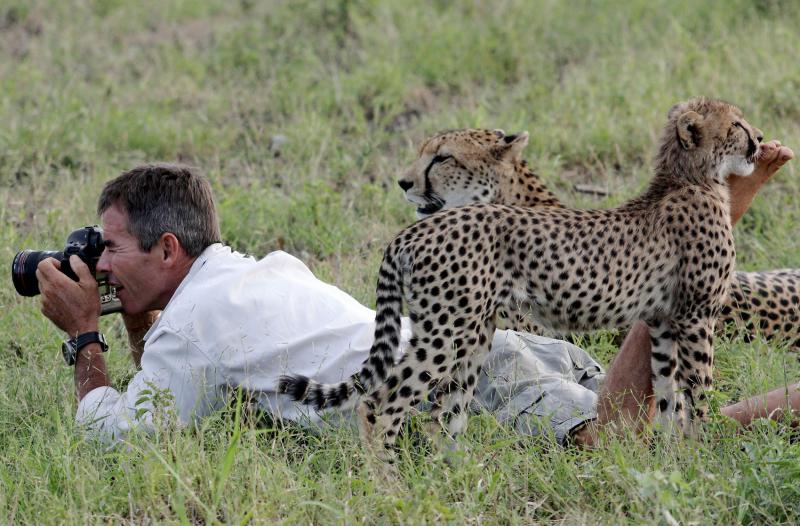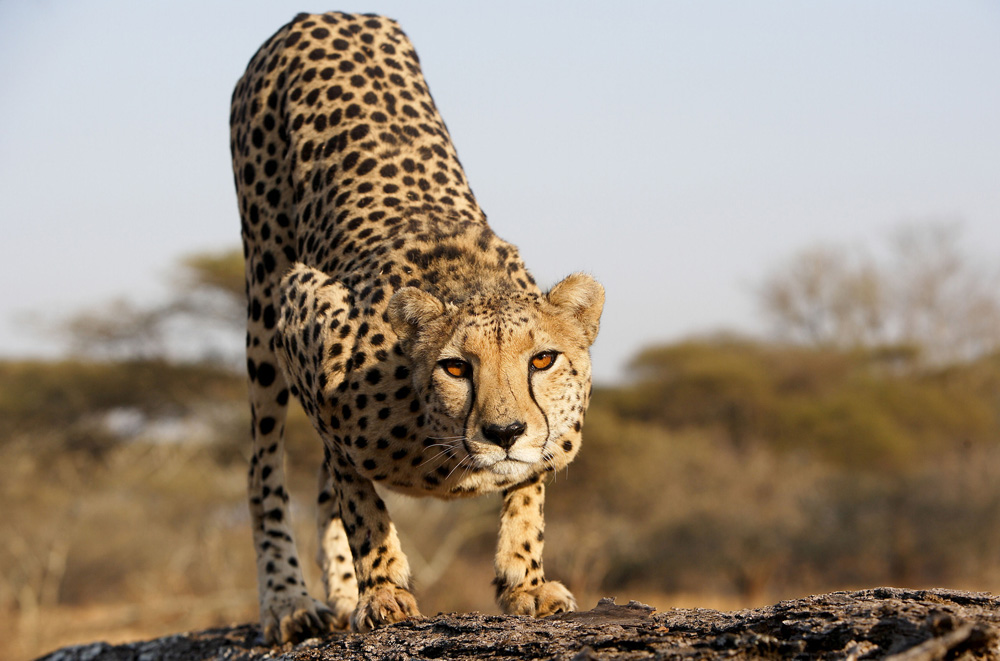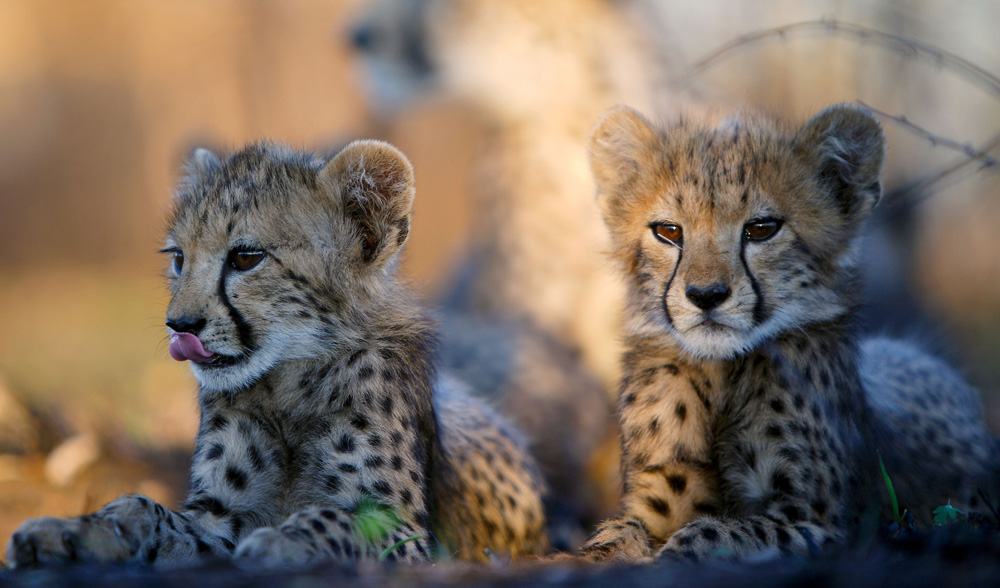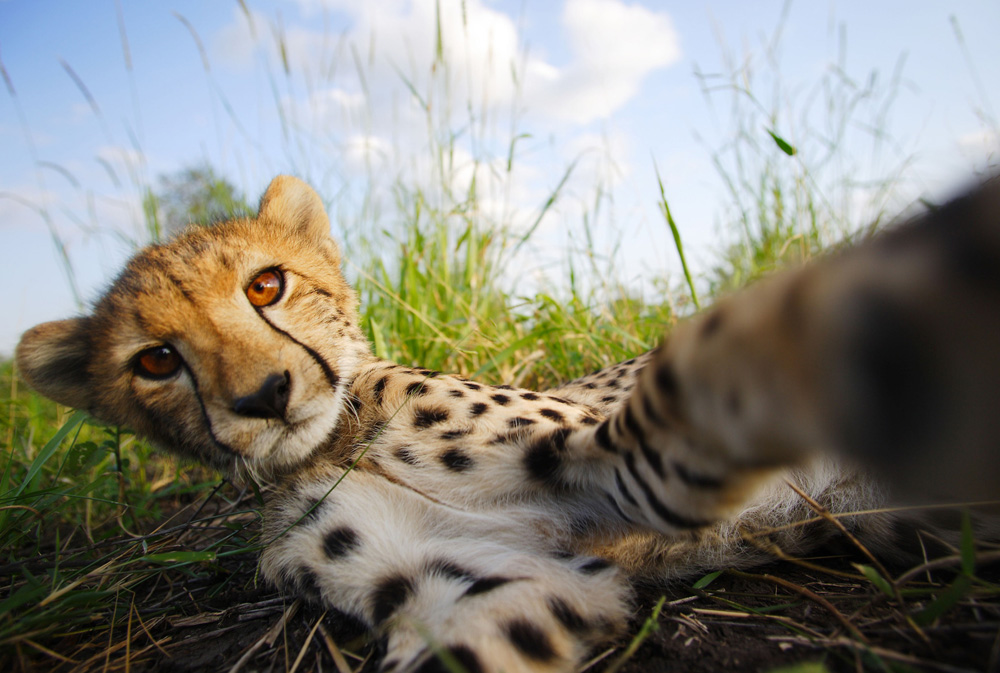Cheetahs: Growing Up Fast - Natural World, BBC Two | reviews, news & interviews
Cheetahs: Growing Up Fast - Natural World, BBC Two
Cheetahs: Growing Up Fast - Natural World, BBC Two
Speedy cats battle for survival in the African wild

Oh clever title: cheetahs, when fully grown at about 18 months, are the fastest mammal on earth, clocking 70 miles per hour in short bursts. For this documentary, we were in the magnificent country of Zimbabwe, in all seasons, following a cheetah family which uncharacteristically lived in forest as well as river plain.
Guided by the soothing and authoritative voice of Sir David Attenborough, armed with an elegant script, we followed the fortunes over nearly two years of a mother cheetah and her five cubs, four females and a male. We were enabled to do this by the cameraman and conservationist, the south African Kim Wolhuter, who has actually been able to get up close and personal to this family group (cheetah mom, below).
 Once common, cheetahs are now an endangered species in their natural habitats, because of human encroachment. As successful predators, the animals come into conflict with farmers who illegally – as cheetahs are officially protected – shoot them to protect their lifestock. It's a short-sighted policy because if one cheetah is removed from the huge territory it patrols, another will move in. One thing this progamme omitted was any discussion of the current state of cheetahs and the efforts being made to sustain their survival.
Once common, cheetahs are now an endangered species in their natural habitats, because of human encroachment. As successful predators, the animals come into conflict with farmers who illegally – as cheetahs are officially protected – shoot them to protect their lifestock. It's a short-sighted policy because if one cheetah is removed from the huge territory it patrols, another will move in. One thing this progamme omitted was any discussion of the current state of cheetahs and the efforts being made to sustain their survival.
The life is tough, even without human hostility. Unlike lions, male cheetahs will not attempt to kill cubs not their own, but they do come round the females from time to time, sniffing and marking their territories, in efforts to mate. As we witnessed, when the female cheetah is not hormonally ready, nothing can happen and the males prowl away elsewhere.
For in cheetahville, the mothers are always single mothers, bringing up their cubs and teaching them to hunt all on their own. The poignant climax showed us the mother, after some 18 months and more of continual maternal concern and care, wandering off herself, spraying as she went to show herself ready for another brief encounter with an eager male.
 At the beginning, we first saw the mother, already known to our guide Kim, with her five cubs, each bearing a rather stylish fur ruff along their backs the better to help them camouflage their hiding places in the long grass. This was literally a fur which they outgrew. At first the breast-fed babies couldn't understand their mother’s appetite for fresh killed meat – antelope, impala, klipspringer. But soon enough the lessons in hunting began, though not before the family itself suffered casualties. Once there were five juveniles, but one young female cub simply disappeared. Our intrepid guide Kim could find no clues as to the cub’s fate, but assumed the worst. Kim named the lone male, who was typically adventurous and even foolhardly, Solo, and then he too disappeared. But Solo’s body, partially eaten, was found at the base of a tree: a leopard, a lion?
At the beginning, we first saw the mother, already known to our guide Kim, with her five cubs, each bearing a rather stylish fur ruff along their backs the better to help them camouflage their hiding places in the long grass. This was literally a fur which they outgrew. At first the breast-fed babies couldn't understand their mother’s appetite for fresh killed meat – antelope, impala, klipspringer. But soon enough the lessons in hunting began, though not before the family itself suffered casualties. Once there were five juveniles, but one young female cub simply disappeared. Our intrepid guide Kim could find no clues as to the cub’s fate, but assumed the worst. Kim named the lone male, who was typically adventurous and even foolhardly, Solo, and then he too disappeared. But Solo’s body, partially eaten, was found at the base of a tree: a leopard, a lion?
Then another female cub just seemed to collapse, lacking even the energy to follow their mother. Bleeding from her nose, she succumbed to a mysterious disease and died within the day. Meanwhile her sister was mauled by a baboon and displayed a festering wound on her shoulder. The wound was swarmed by biting ants, and the youngster was traumatised. But here human help was on hand. Usually the wilderness vets only intervene when trouble has been caused by humans: animals wounded by poaching for instance, and not endangered simply by the normal risks of their lives. But as the cheetahs are an endangered species, this suffering cub was sewn up, medicated and recovered.
 The mother persevered, teaching her cubs to scan the countryside for prey by climbing trees. Only the smaller deer were possible victims, and there was a funny sequence as a zebra was dismissed as too big, giraffes as too tall, and elephants as way too large. Weaned, the hungry cubs learned to hunt down their natural prey, and we saw the techniques they learned from mum. The prey is brought down and killed by strategic bites to the throat which suffocate it. We also saw sequences when seemingly-dead deer suddenly got up and in a desperate quest for life tried to get away – sometimes successfully.
The mother persevered, teaching her cubs to scan the countryside for prey by climbing trees. Only the smaller deer were possible victims, and there was a funny sequence as a zebra was dismissed as too big, giraffes as too tall, and elephants as way too large. Weaned, the hungry cubs learned to hunt down their natural prey, and we saw the techniques they learned from mum. The prey is brought down and killed by strategic bites to the throat which suffocate it. We also saw sequences when seemingly-dead deer suddenly got up and in a desperate quest for life tried to get away – sometimes successfully.
The family communicated not only with body language but with a lot of vocalising, well understood by the cheetahs if not us. The penultimate sequence showed us the departure of the mother; after all her amazing care, she knew when it was time to leave her cubs in the territory in which they had grown up. She was mourned by one of the sisters with little cries for two full days; the other did not even seem to notice.
Amidst the fascination of the cheetahs who so helpfully for the film makers hunt by day, it is of course nature red in tooth and claw that is the real subject: life – eat or be eaten – and death. The final moment though was when Kim evidently came upon one of the full-grown sisters, and this wild animal walked up to him – and licked his face. Aw...
The future of Arts Journalism
You can stop theartsdesk.com closing!
We urgently need financing to survive. Our fundraising drive has thus far raised £49,000 but we need to reach £100,000 or we will be forced to close. Please contribute here: https://gofund.me/c3f6033d
And if you can forward this information to anyone who might assist, we’d be grateful.

Subscribe to theartsdesk.com
Thank you for continuing to read our work on theartsdesk.com. For unlimited access to every article in its entirety, including our archive of more than 15,000 pieces, we're asking for £5 per month or £40 per year. We feel it's a very good deal, and hope you do too.
To take a subscription now simply click here.
And if you're looking for that extra gift for a friend or family member, why not treat them to a theartsdesk.com gift subscription?
more TV
 theartsdesk Q&A: writer and actor Mark Gatiss on 'Bookish'
The multi-talented performer ponders storytelling, crime and retiring to run a bookshop
theartsdesk Q&A: writer and actor Mark Gatiss on 'Bookish'
The multi-talented performer ponders storytelling, crime and retiring to run a bookshop
 Ballard, Prime Video review - there's something rotten in the LAPD
Persuasive dramatisation of Michael Connelly's female detective
Ballard, Prime Video review - there's something rotten in the LAPD
Persuasive dramatisation of Michael Connelly's female detective
 Bookish, U&Alibi review - sleuthing and skulduggery in a bomb-battered London
Mark Gatiss's crime drama mixes period atmosphere with crafty clues
Bookish, U&Alibi review - sleuthing and skulduggery in a bomb-battered London
Mark Gatiss's crime drama mixes period atmosphere with crafty clues
 Too Much, Netflix - a romcom that's oversexed, and over here
Lena Dunham's new series presents an England it's often hard to recognise
Too Much, Netflix - a romcom that's oversexed, and over here
Lena Dunham's new series presents an England it's often hard to recognise
 Insomnia, Channel 5 review - a chronicle of deaths foretold
Sarah Pinborough's psychological thriller is cluttered but compelling
Insomnia, Channel 5 review - a chronicle of deaths foretold
Sarah Pinborough's psychological thriller is cluttered but compelling
 Live Aid at 40: When Rock'n'Roll Took on the World, BBC Two review - how Bob Geldof led pop's battle against Ethiopian famine
When wackily-dressed pop stars banded together to give a little help to the helpless
Live Aid at 40: When Rock'n'Roll Took on the World, BBC Two review - how Bob Geldof led pop's battle against Ethiopian famine
When wackily-dressed pop stars banded together to give a little help to the helpless
 Hill, Sky Documentaries review - how Damon Hill battled his demons
Alex Holmes's film is both documentary and psychological portrait
Hill, Sky Documentaries review - how Damon Hill battled his demons
Alex Holmes's film is both documentary and psychological portrait
 Outrageous, U&Drama review - skilfully-executed depiction of the notorious Mitford sisters
A crack cast, clever script and smart direction serve this story well
Outrageous, U&Drama review - skilfully-executed depiction of the notorious Mitford sisters
A crack cast, clever script and smart direction serve this story well
 Prost, BBC 4 review - life and times of the driver they called 'The Professor'
Alain Prost liked being world champion so much he did it four times
Prost, BBC 4 review - life and times of the driver they called 'The Professor'
Alain Prost liked being world champion so much he did it four times
 The Buccaneers, Apple TV+, Season 2 review - American adventuresses run riot in Cornwall
Second helping of frothy Edith Wharton adaptation
The Buccaneers, Apple TV+, Season 2 review - American adventuresses run riot in Cornwall
Second helping of frothy Edith Wharton adaptation
 The Gold, Series 2, BBC One review - back on the trail of the Brink's-Mat bandits
Following the money to the Isle of Man, Spain and the Caribbean
The Gold, Series 2, BBC One review - back on the trail of the Brink's-Mat bandits
Following the money to the Isle of Man, Spain and the Caribbean
 Dept. Q, Netflix review - Danish crime thriller finds a new home in Edinburgh
Matthew Goode stars as antisocial detective Carl Morck
Dept. Q, Netflix review - Danish crime thriller finds a new home in Edinburgh
Matthew Goode stars as antisocial detective Carl Morck

Add comment